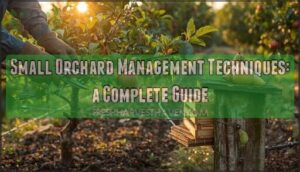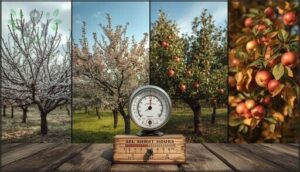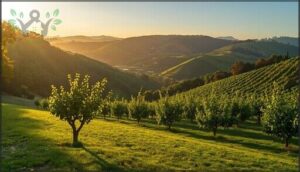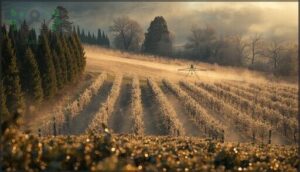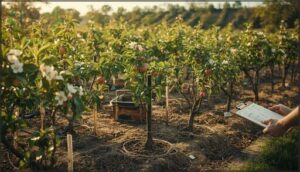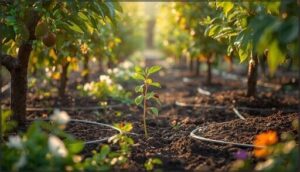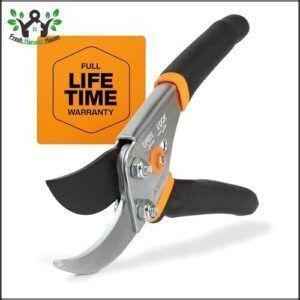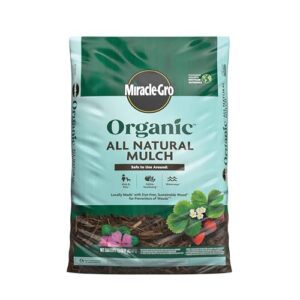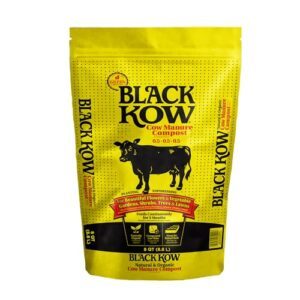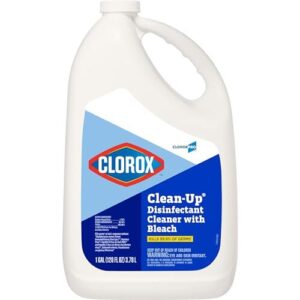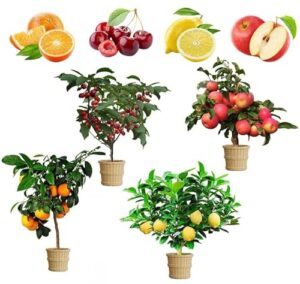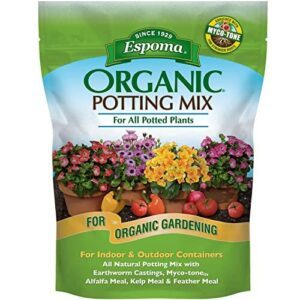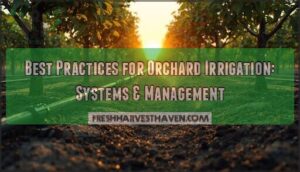This site is supported by our readers. We may earn a commission, at no cost to you, if you purchase through links.
You can’t rush a tree, but you can certainly ruin one. Most new orchard owners learn this lesson the hard way—through a spring frost that wipes out their blossoms, poor soil drainage that drowns root systems, or a pruning mistake that costs them two years of growth.
Managing a small orchard isn’t just about planting fruit trees and waiting for harvest. It requires understanding your local climate zones, selecting disease-resistant varieties that match your region’s chill hours, and implementing seasonal tasks at precisely the right moments.
The difference between a thriving orchard and a struggling one often comes down to soil preparation, proper irrigation timing, and consistent record keeping. When you master these small orchard management techniques, you’ll transform scattered trees into a productive system that yields quality fruit year after year.
Table Of Contents
- Key Takeaways
- Choosing The Best Orchard Location
- Selecting Fruit Tree Varieties
- Essential Orchard Management Techniques
- Sustainable Soil, Water, and Pest Management
- Top 10 Tools and Products for Small Orchards
- 1. Fiskars Bypass Pruning Shears Clippers Steel
- 2. Miracle-Gro Organic All Natural Mulch
- 3. Jonathan Green Corn Gluten Fertilizer
- 4. Pantry Moth Traps Safe Effective Glue
- 5. Black Kow Composted Cow Manure Fertilizer
- 6. Clorox Clean Up Disinfectant Refill
- 7. Dwarf Bonsai Fruit Tree Seed Mix
- 8. Durable Garden Netting Plant Cover
- 9. Espoma Organic Potting Soil Mix
- 10. Bloom City Organic Kelp Fertilizer
- Frequently Asked Questions (FAQs)
- How do I transition from conventional to organic orchard management?
- What are signs my fruit trees need emergency intervention?
- Can I successfully mix different fruit species together?
- How do I calculate realistic yield expectations by tree age?
- What insurance or legal protections do small orchards need?
- Conclusion
Key Takeaways
- Your orchard’s location determines success more than any other factor—prioritize climate zones, chill hours, well-drained soil with 3-5% organic matter, and slopes of 4-8% that naturally channel cold air away from vulnerable trees.
- Disease-resistant varieties matched to local conditions cut fungicide use by 50-80%, while proper pollination planning ensures cross-pollinating trees bloom within 50 feet of each other for reliable fruit set.
- Timing pruning to phenological stages rather than calendar dates, thinning fruit within 30 days of bloom, and maintaining detailed records improves yield forecasting accuracy to within 8-15%.
- Integrated pest management using exclusion netting, beneficial insects, and targeted monitoring reduces pesticide use by 30-50% while maintaining yields, with ultra-fine mesh blocking 94-96% of key pests in field trials.
Choosing The Best Orchard Location
Your orchard’s location makes or breaks everything that comes after—it shapes how your trees grow, what you’ll face season to season, and ultimately what you’ll harvest. Before you pick a spot and start digging, you need to understand the key factors that’ll determine whether your orchard thrives or just survives.
Your orchard’s location makes or breaks everything—from how your trees grow to what you’ll ultimately harvest
Let’s walk through what to look for when you’re evaluating your land.
Assessing Climate and Temperature
Where should your orchard actually thrive? Your location’s climate determines everything. Start by identifying your USDA hardiness zone—it tells you the minimum winter temperatures your trees can survive. Next, count your chill hours, those important dormant-season temperatures between 32 and 45°F that most fruit trees need to break dormancy.
For fruit trees to properly bud, they need a specific number of chill hours. Check your growing season length and accumulated heat units.
Evaluating Soil Quality and Drainage
Now that you’ve pinpointed the right climate, soil becomes your next critical decision. Your soil quality and drainage directly determine whether trees thrive or struggle.
Start with soil testing—you’ll need pH levels between 6.0 and 7.0 for prime nutrient availability. Check soil texture, water retention capacity, and drainage improvement needs. Compaction restricts rooting depth, so assess bulk density.
Well-structured loam with 3–5% organic matter fosters healthy root systems and prevents waterlogging that kills young trees. Fruit trees also need well-drained soil to prevent root rot.
Considering Topography and Sun Exposure
With your soil foundation set, topography becomes your next strategic advantage. Slopes of 4–8% improve water runoff and air drainage, reducing frost risk while improving soil stability. Steeper terrain naturally channels cold air away, protecting your crop during vulnerable frost periods.
South-facing slopes warm faster, accelerating fruit ripening, whereas north-south row orientation maximizes sunlight and air circulation. Most fruit trees need 6–8 hours of direct sun daily for best growth and quality.
Planning for Wind Protection and Frost Risk
Wind and frost can undo years of work, so don’t overlook them when siting your orchard. Multi-row windbreaks reduce wind speed by roughly 50% across protected zones, lessening damage and spray drift considerably.
For frost protection, avoid low-lying areas where cold air pools—instead, choose upper slopes with 4–8% grades that promote drainage. Positioning windbreaks perpendicular to prevailing winds maximizes their benefit.
Combine smart site selection with active systems like sprinklers or wind machines for thorough frost defense.
Selecting Fruit Tree Varieties
The right fruit trees make all the difference in how your orchard performs year after year. You’ll want to think about your climate, pollination needs, disease resistance, and what actually grows well in your area.
Let’s walk through the key factors that’ll help you pick varieties that thrive where you’re and deliver the results you’re looking for.
Matching Varieties to Local Climate
Your fruit tree varieties must match your local climate, or you’ll fight an uphill battle every season. Cold hardiness zones determine winter survival, while chill hour needs—the accumulated hours between 32°F and 45°F—control whether trees break dormancy and fruit properly.
Climate change impacts are shifting these patterns: projections show 30–80% fewer chill hours by 2050 in some regions. Select low-chill cultivars if winters warm, or high-chill varieties only if your zone reliably delivers the required hours.
Phenological disturbances from erratic winters mean you’re choosing for adaptation, not just tradition.
Understanding Pollination Requirements
Pollination makes or breaks your harvest, so understand what your varieties actually need. Some fruit trees like apples and pears demand cross-pollination with compatible cultivars blooming simultaneously, while others—peaches, nectarines, apricots—self-pollinate but still benefit from insect pollinators.
Plant cross-pollinating varieties within 50 feet of each other, ensuring bloom synchrony. Honeybees are your workhorses here. Self-fertile trees still produce heavier crops with a pollinizer present, so don’t skip this step.
Evaluating Disease Resistance
How do you know which varieties will actually thrive in your orchard? Disease resistance matters far more than most growers realize. Research shows only 8.8% of apple cultivars exhibit very low scab resistance, and genetic resistance can break down over time.
Evaluate cultivars against regional disease pressure—fire blight devastates Washington orchards regularly, while powdery mildew thrives in specific humidity patterns. Match resistant varieties to your local climate, then layer integrated pest management tactics for reliable protection.
Considering Market and Personal Preferences
Your variety choices should balance what your market actually wants with what you can profitably grow. Consumer demand increasingly favors locally grown fruit—58% of consumers prefer it—while premium segments like berries and avocados capture growing market share.
Consider these factors:
- Market timing through early or late-harvest varieties
- Direct-to-consumer appeal emphasizing quality and freshness
- Varieties requiring fewer chemical inputs for organic certification
- Self-fertile options reducing pollination complexity
This business acumen drives sustainability trends and personal enjoyment together.
Essential Orchard Management Techniques
Now that you’ve chosen your varieties, it’s time to learn how to actually manage your orchard day-to-day. The techniques that follow will help you stay on top of seasonal tasks, keep your trees healthy, and increase what you harvest each year.
Think of these as the core practices that separate orchards that thrive from ones that just survive.
Seasonal Orchard Task Scheduling
Timing is everything in orchard management. Your seasonal tasks must anchor to phenological stages—budbreak, bloom, fruit set—rather than fixed calendar dates, since weather varies by region and year. This phenological anchoring ensures you’re tackling the right job at the right moment.
Integrate tasks into a master calendar, adjust for local conditions, and document everything you do. Record keeping reveals patterns that guide next season’s strategy, transforming reactive maintenance into purposeful, predictive orchard care.
Pruning Methods and Timing
Pruning shapes your orchard’s future. Dormant pruning in late January through early March—when buds haven’t swelled and temperatures stay above freezing—minimizes disease spread and cold injury. Summer pruning controls vigor by reducing shoot length, boosting flower bud formation. Your pruning severity matters: moderate cuts outperform aggressive ones.
Training systems like central leader establish strong structure early. Sanitation pruning removes infected growth, preventing fire blight spread. Match your pruning techniques and timing to your trees’ phenological stage, not the calendar.
Fruit Thinning for Quality Yield
After pruning establishes structure, thinning becomes your lever for quality. Remove excess fruit early—within 30 days of bloom—before cell division stops and fruit loses responsiveness. This single practice drives larger apples, better color, and stronger return flowering next season.
Target crop load using trunk cross-sectional area: Honeycrisp needs 4 fruits per cm², while other varieties handle 5 per cm². Chemical thinning followed by hand work gets you there.
- Early post-bloom intervention maximizes fruit size gains
- Delayed thinning yields diminishing returns on quality
- Proper crop load reduces biennial bearing patterns
- Larger fruit commands premium market prices
- Balanced load strengthens next year’s flowering
Record Keeping and Growth Monitoring
Now that you’ve shaped your trees through pruning and thinning, tracking what happens next separates thriving orchards from struggling ones. Digital record-keeping systems capture the story your orchard tells—phenology monitoring, labor tracking, yield records, and weather data all work together to reveal patterns.
Start simple: date your bloom periods, document pruning responses, and log harvest outcomes. Sensor integration tracks soil moisture and canopy growth. Studies show growers using systematic records improve yield forecasting accuracy to within 8–15%, letting you plan confidently for next season.
| Record Type | Frequency | Why It Matters |
|---|---|---|
| Phenology (bloom, bud break) | Weekly during season | Predicts frost risk, optimizes spray timing |
| Labor hours by task | Daily | Allocates 40–70% of costs accurately |
| Soil moisture | 15–60 minute intervals | Guides irrigation decisions, prevents stress |
| Harvest dates and yield | Per block, annually | Builds forecasting models, tracks variety performance |
| Weather extremes | Real-time | Connects frost events to yield losses |
Tool Maintenance and Storage
Your pruning shears are only as good as their maintenance. Keep blades sharp—a 10–20° bevel reduces cutting force by 20–30% and prevents tree damage.
Clean tools immediately with warm soapy water; dried blades resist rust for months, while neglected ones corrode within weeks. Disinfect between trees using 70% alcohol or 10% bleach to stop disease spread.
Store tools hung on wall racks in dry conditions below 60% humidity, and oil moving parts annually. Well-maintained equipment lasts decades, protecting both your trees and your hands.
Sustainable Soil, Water, and Pest Management
The foundation of a thriving orchard rests on three critical pillars: healthy soil, reliable water management, and effective pest control. These elements work together to protect your investment and keep your trees producing year after year.
Let’s walk through each strategy you’ll need to build a sustainable system that works for your specific conditions.
Soil Preparation and Nutrient Management
Your soil is the foundation of everything that happens above ground. Start with soil testing every three to five years—more frequently when you’re first establishing your orchard—to measure pH, texture, and nutrient levels. Target a pH around 7.0 in the topsoil and 6.5 in the subsoil for best nutrient availability.
Nitrogen strategies should match tree age, starting at 30 grams per tree in year one and increasing gradually. Organic amendments like compost boost soil fertility and structure, creating the root environment your trees need to thrive for decades.
Mulching and Composting Practices
With mulch and compost, you’re building soil health from the ground up. A 2–4 inch mulch layer cuts weeds by 60–75% while boosting soil moisture retention. Organic mulches improve water infiltration and reduce runoff, moderating root-zone temperatures.
Annual compost applications increase soil organic matter and cation exchange capacity, supporting larger canopies and higher yields. On-farm compost closes nutrient loops, reducing synthetic fertilizer dependence while sequestering carbon—a win for both your orchard and the environment.
Irrigation Strategies and Water Conservation
Water scarcity doesn’t have to limit your orchard’s potential—it’s about choosing the right irrigation approach for your conditions. Drip systems achieve 90–95% efficiency, while micro-irrigation cuts water use by 30–50%.
Precision scheduling with soil sensors reduces consumption by over 50% while boosting yields. Consider deficit irrigation strategies for moderate water reduction without severe yield loss.
Drought-tolerant rootstocks like Rangpur lime improve resilience, and rainwater harvesting captures seasonal abundance for dry periods.
Integrated Pest Management (IPM)
Pest pressure can make or break your orchard’s profitability, but you don’t need to spray everything that moves. Integrated Pest Management (IPM) uses targeted monitoring and biological controls to reduce pesticide use by 30–50% while maintaining yields. Studies show IPM adoption increases natural enemy populations and improves fruit quality, boosting profits by around 20% over five years through lower chemical costs.
Your core IPM strategies:
- Scout weekly using pheromone traps and visual monitoring to track pest populations
- Set economic thresholds—spray only when pest damage costs exceed treatment expenses
- Encourage natural enemies by reducing broad-spectrum insecticides that kill beneficial insects
- Time interventions with fruit-tree growth stages to align with pest biology
- Track data systematically: pest counts, weather patterns, and treatment outcomes for continuous improvement
Disease Prevention and Organic Controls
Your disease strategy starts with resistant cultivars—varieties like ‘GoldRush’ and ‘Enterprise’ can eliminate routine fungicide sprays while maintaining yields.
Combine this foundation with cultural practices: remove infected leaves, prune diseased wood, and improve sanitation to cut scab inoculum by 50–80%.
Layer in organic fungicides like copper and sulfur, then add biological agents such as Trichoderma isolates for preventative control.
This integrated approach delivers comparable disease outcomes to conventional systems while building long-term orchard resilience.
Top 10 Tools and Products for Small Orchards
Running a small orchard means having the right equipment on hand—it makes the difference between managing your trees efficiently and struggling through the season. The tools and products you choose affect everything from how well you prune to how healthy your soil stays, which directly impacts your harvest.
Here are ten reliable options that’ll help you get the job done right.
1. Fiskars Bypass Pruning Shears Clippers Steel
When you’re making hundreds of cuts during dormant season pruning, your tool matters. The Fiskars bypass pruning shears deliver precisely what orchardists need: hardened steel blades that hold their edge through repeated use, a 5/8-inch cutting capacity ideal for spur renewal and shoot thinning, and an ergonomic design that won’t fatigue your hand.
The rust-resistant coating and self-cleaning sap groove keep blades performing season after season. At around fifteen dollars, they’re an accessible investment backed by a lifetime warranty—the kind of reliable workhorse you’ll reach for year after year.
Best For: Orchardists and gardeners who need a reliable, ergonomic hand tool for hundreds of small cuts during dormant season pruning and everyday maintenance work.
- Hardened steel blades with rust-resistant coating hold their edge through repeated cutting, backed by a lifetime warranty for long-term durability
- 5/8-inch cutting capacity and self-cleaning sap groove keep the tool performing smoothly without blade sticking or gumming during intensive pruning sessions
- Ergonomic non-slip grip and lightweight design (10.2 oz) reduce hand fatigue during extended use, making it practical for detailed canopy management
- Some users report blades can separate over time with heavy use, requiring occasional maintenance or replacement
- The lock mechanism can be finicky to operate compared to simpler designs on competing pruners
- At 10.2 ounces, it’s slightly heavier than some other Fiskars models, which may matter if you’re sensitive to tool weight during long pruning sessions
2. Miracle-Gro Organic All Natural Mulch
Protecting your orchard floor from weeds and moisture loss starts with the right organic matter. Miracle-Gro Organic All Natural Mulch delivers OMRI certification for organic gardens, using dye-free recycled wood that won’t leach into edibles.
Apply a 3-inch application depth around trees—that’s your sweet spot for weed suppression and moisture retention without nitrogen tie-up. Each 1.5 cubic foot bag covers six square feet, making it straightforward to calculate needs.
It’s a soil amendment that works double duty: blocking competing weeds while keeping roots hydrated between waterings, reducing your environmental impact through locally-sourced production.
Best For: Organic orchardists and fruit growers who need certified weed control around established trees without risking chemical contamination of edibles.
- OMRI-listed and dye-free so it’s safe around fruit trees, vegetables, and waterways without leaching concerns
- Locally manufactured from recycled wood waste, cutting transportation emissions while diverting lumber scraps from landfills
- Three-inch layer blocks weeds naturally and helps retain soil moisture, reducing watering frequency in orchards
- Not suitable around young or underdeveloped trees since decomposing wood can temporarily tie up nitrogen that new plantings need
- Must be kept several inches away from tree trunks and wood structures to prevent moisture damage and rot
- Some users report it takes a long time to absorb water initially, which may affect how quickly it helps with moisture retention
3. Jonathan Green Corn Gluten Fertilizer
While mulch addresses surface moisture and physical weed barriers, you’ll need something that stops weeds before they germinate. Jonathan Green Corn Gluten Fertilizer delivers dual-purpose orchard floor management: pre-emergent weed suppression plus 10% nitrogen for soil fertility.
Apply your 15 lb bag over 5,000 square feet in early spring when soil hits 50–55°F—that application timing shuts down crabgrass and dandelions before they sprout.
It’s environmental safety meets integrated management, feeding trees while controlling competition. Safe around kids and pets, this soil amendment builds long-term soil health through repeated seasonal use in your organic gardening system.
Best For: Organic growers and homeowners who want a natural, pet-safe pre-emergent that feeds the lawn while preventing crabgrass and dandelions from taking hold.
- Dual action formula provides 10% nitrogen fertilization alongside pre-emergent weed control, handling two lawn tasks in one application
- Safe for children and pets when used as directed, making it ideal for family yards and high-traffic areas
- Works on multiple surfaces including lawns, flower gardens, and planting beds, offering flexible use across your property
- Higher price point compared to synthetic pre-emergents, which may stretch budgets on larger properties
- Requires precise early spring timing (soil temp 50–55°F) to be effective, and won’t kill weeds that have already sprouted
- May need multiple seasons of use to see full weed suppression results, so it’s not a quick fix for heavily infested lawns
4. Pantry Moth Traps Safe Effective Glue
When dried fruit or nuts from your harvest move into storage, you’re facing a new pest management challenge—pantry moths. Trap A Pest’s pheromone-based glue traps catch adult males before they mate, breaking the infestation cycle without chemicals near food.
Place these non-toxic traps on shelves storing cereals, dried apples, or walnuts; their 8–12 week trap lifespan and safe adhesive composition make them ideal for integrated storage pest control.
You’ll protect your orchard’s value-added products while monitoring pest outbreaks early, aligning postharvest practices with your field-level integrated pest management system.
Best For: Small orchard operators and home preservers who store dried fruit, nuts, or grains and need chemical-free pantry moth monitoring that integrates with their broader pest management approach.
- Pheromone lures target male pantry moths specifically, disrupting breeding cycles without pesticides or odors near stored food
- Non-toxic glue and 8–12 week lifespan let you monitor multiple storage zones continuously with minimal maintenance
- Foldable tent design keeps sticky surfaces away from accidental contact while catching dozens of moths per trap
- Works best as part of a broader plan—you’ll still need to clean shelves, vacuum cracks, and toss infested packages for full control
- Only traps pantry moths, so it won’t help with clothes moths or other storage pests that might show up
- Glue can catch beneficial insects or small animals if traps aren’t placed carefully away from open areas
5. Black Kow Composted Cow Manure Fertilizer
You’ll want Black Kow composted cow manure in your fertility program—it brings 0.5–0.5–0.5 N–P–K plus stable organic matter that transforms both sandy and clay soils.
Apply 10 pounds per year of tree age, up to 100 pounds per mature tree, spreading it under the canopy to your drip line each spring.
This composting process heats piles to 150°F, destroying weed seeds while creating millions of beneficial bacteria for nutrient mineralization. You’re building soil structure, boosting moisture retention, and supporting long-term orchard health without root burn.
Best For: Orchard growers and gardeners who need to improve soil structure and moisture retention in sandy or clay soils while adding slow-release organic nutrients without risking root burn on young or sensitive trees.
- Improves both sandy and clay soils by adding organic matter that increases water retention in sandy ground and creates better aeration in dense clay
- Contains beneficial bacteria and slow-release nutrients (0.5–0.5–0.5 N–P–K) that won’t burn roots, making it safe for young trees and establishing orchards
- Composting process reaches 150°F to eliminate weed seeds and pathogens, with testing for herbicide residues to ensure clean application in organic programs
- More expensive than raw manure or some competing soil amendments, which can add up when treating multiple mature trees at 100 pounds each
- Some batches have arrived with fungus gnat infestations, creating pest management issues in orchards and gardens
- Lower nutrient analysis means you’ll likely need supplemental fertilizers for high-demand fruit trees, especially during peak production years
6. Clorox Clean Up Disinfectant Refill
Sanitation matters when you’re rotating between trees for pruning, thinning, or pest inspection. Clorox Clean-Up’s 1.84% sodium hypochlorite kills 99.9% of bacteria and viruses on your harvest bins, tool grips, and packing benches—the hard surfaces where pathogens hitch rides.
Apply it undiluted, let surfaces stay wet for 30 seconds, then rinse food-contact areas with clean water. Dilute one cup per gallon for floors. Always work in ventilated spaces, wear gloves, and never mix with ammonia-based cleaners.
Orchard sanitation protects tree care investments and keeps disease control protocols sharp.
Best For: Orchard operators and small growers who need a reliable disinfectant for harvest equipment, packing surfaces, and high-touch tools between pruning or thinning cycles.
- Kills 99.9% of bacteria and viruses with just 30 seconds of wet contact time, making it fast enough for busy harvest days
- The 128-ounce refill size cuts down on packaging waste and gives you plenty for repeated use across bins, benches, and tool handles
- Works undiluted for disinfection or diluted (1 cup per gallon) for mopping floors, so one bottle handles multiple cleaning tasks
- Strong bleach smell requires good ventilation, which can be tricky in enclosed packhouses or storage sheds
- Not safe for porous materials, unsealed wood, or delicate surfaces like marble—you’ll need alternatives for some orchard structures
- Must rinse food-contact surfaces after use, adding an extra step when you’re cleaning sorting tables or harvest containers
7. Dwarf Bonsai Fruit Tree Seed Mix
Growing dwarf trees from seed tests your patience more than your wallet. This mix packs apple, lemon, cherry, and orange seeds—50 per variety—but expect 30% germination under hobby conditions.
Temperate fruit species need one to two months of cold stratification in your refrigerator, then 60 to 80 °F with moderate humidity.
Seed-grown fruit trees can take ten to twenty years to bear, so if you want faster harvests, grafted nursery stock beats seeds. Still, starting dwarf bonsai fruit from scratch offers long-term tree selection control and deep satisfaction.
Best For: Patient hobbyists who want the satisfaction of raising fruit trees from scratch and have the space and years to commit to a very long-term bonsai project.
- Includes four different fruit varieties (apple, lemon, cherry, orange) in one affordable pack, so you can experiment with multiple species without buying separate packets.
- Non-GMO heirloom seeds with moisture-resistant packaging help preserve viability during storage.
- Offers complete control over tree selection and training from germination onward, rewarding for dedicated bonsai enthusiasts.
- Germination rates around 30% under typical home conditions mean many seeds won’t sprout, even with proper stratification.
- Seed-grown fruit trees can take ten to twenty years before they produce any fruit, making this a decade-plus commitment.
- Temperate species require one to two months of cold stratification in the refrigerator before sowing, adding extra prep time and care.
8. Durable Garden Netting Plant Cover
You’ll cut codling moth captures by 94% and apple maggot pressure by 96% with exclusion netting, Minnesota trials confirm. Ultra-fine mesh—0.8 mm apertures—blocks pests while allowing rain and light through, creating microclimate effects that reduce wind stress without trapping humidity.
Field-tested polyethylene lasts three to five years with UV stabilizers, protecting 87–115 million USD worth of Honeycrisp crops annually across five states. Anchor edges firmly; wind tears weak points fast.
Netting transforms pest control from reactive sprays into proactive, organic pest prevention, delivering operational simplicity and measurable economic impact for small orchards.
Best For: Small-orchard growers and home gardeners who want proven pest exclusion without relying on chemical sprays—especially if you’re protecting high-value crops like apples, cherries, or berries from codling moth, apple maggot, and bird damage.
- Cuts pest pressure by 94–96% in field trials, giving you organic-level protection that actually works without constant reapplication or resistance worries.
- Lasts 3–5 years with UV stabilizers, so you’re spreading the cost over multiple seasons instead of buying disposable solutions every year.
- Lets rain, air, and light through while reducing wind stress, meaning your plants stay healthy and you’re not creating a humidity trap that invites disease.
- Needs solid anchoring or wind will find weak spots and rip the mesh—not ideal if you’re in an exposed, gusty location without good ground stakes or weighted edges.
- Some users report the material tears more easily than expected, so you’ll want to inspect regularly and patch small holes before they spread.
- Visibility drops in bright sun because of the white mesh, making it harder to monitor plants or spot problems without getting close.
9. Espoma Organic Potting Soil Mix
You’ll build lasting soil health in pots with Espoma’s peat–humus–perlite base, enriched with earthworm castings and kelp meal for organic certification compatibility.
The Myco-tone blend delivers 3.4 million propagules per cubic foot—mycorrhizae benefits include drought tolerance and nutrient uptake in container fruit trees.
Moisture management improves through yucca extract, preventing waterlogging while retaining irrigation between waterings.
Long-term performance requires occasional organic top-dressing as initial amendments deplete, but container suitability for dwarf rootstocks makes this mix a reliable foundation for small-orchard soil preparation and sustained soil management practices.
Best For: Container gardeners growing herbs, vegetables, or dwarf fruit trees who want an organic-certified potting mix with mycorrhizae support for stronger roots and better drought tolerance.
- Contains 3.4 million mycorrhizal propagules per cubic foot plus earthworm castings and kelp meal, giving your plants a biological boost without synthetic fertilizers.
- Yucca extract works as a natural wetting agent to help water spread evenly through the mix, so you avoid dry spots and waterlogged pockets.
- Available in multiple bag sizes from 4-quart to 2-cubic-foot, making it easy to scale from a few houseplants to a small patio orchard.
- Not sterilized, so some bags may contain small wood pieces, roots, or even bugs and mushrooms—not ideal if you’re starting delicate seedlings.
- Quality can vary depending on how the bags were stored and handled before you buy them.
- Initial nutrients will deplete over time in long-term containers like fruit trees, so you’ll need to add organic fertilizer down the road.
10. Bloom City Organic Kelp Fertilizer
You’ll add a proven biostimulant layer to your fertilization programs with Bloom City’s seven-species kelp blend. Application rates of 5–10 mL per gallon during bloom support nutrient needs without synthetic inputs.
Kelp benefits include improved stress tolerance and fruit set, backed by trials showing yield gains up to 20%. Organic compliance makes it suitable for certified orchards, though you’ll still need a complete fertilization schedule addressing primary macronutrients.
Orchard integration works best as a supplement—nutrient analysis confirms biostimulant effects rather than direct NPK supply, so pair it with balanced fertilizing for sustained results.
Best For: Small orchard growers and organic farmers looking to supplement their fertilization program with a natural biostimulant that improves stress tolerance and fruit set without adding synthetic inputs.
- Seven-species kelp blend provides over 100 beneficial compounds including natural plant hormones, trace minerals, and vitamins that support flowering and fruit development
- Research-backed effectiveness with documented yield increases of 5-20% in fruit crops, plus improved root growth and stress resilience during drought or heat waves
- Simple application at low rates (5-10 mL per gallon) makes it practical for small operations and compatible with organic certification when used alongside a complete fertilization program
- Functions as a supplement rather than a primary fertilizer, so you’ll still need a separate NPK program to meet your trees’ macronutrient requirements
- Some customers reported packaging issues like missing caps or seals that could affect product quality during shipping
- Higher cost per treatment compared to conventional fertilizers, though the concentrated formula does make 180 gallons from a 32-ounce bottle
Frequently Asked Questions (FAQs)
How do I transition from conventional to organic orchard management?
You’ll need a three-year conversion period under USDA organic rules. During this time, manage your orchard organically while documenting soil health practices, pest control methods, and system planning—even though crops can’t carry the organic label yet.
What are signs my fruit trees need emergency intervention?
Sudden wilting, bark cankers, pest damage, nutrient stress, and rapid disease spread demand your immediate attention. Don’t wait—inspect for fungal diseases and borer galleries, then act fast to prevent tree death.
Can I successfully mix different fruit species together?
You can successfully mix different fruit species together if you match tree vigor, pollination compatibility, and rootstock selection. Spatial arrangement supporting cross-pollination while managing disease resistance creates productive, diverse orchards yielding multiple fruit types.
How do I calculate realistic yield expectations by tree age?
Yield benchmarks depend on tree age, rootstock influence, and shoot growth. Young fruit trees generally produce their first meaningful crop around years 3–6, while mature trees reach full fruit production from year 8 onward.
What insurance or legal protections do small orchards need?
You need farm liability insurance, crop insurance for revenue protection, and property coverage for equipment and structures.
Consider forming a legal entity to limit personal exposure and access federal risk support programs.
Conclusion
The orchard you plant this season will outlive most of your garden projects, which means every decision you make now echoes through decades of harvests.
When you apply these small orchard management techniques consistently—from site selection through pest control—you’re not just growing fruit trees. You’re building a system that rewards patience with abundance, transforming your land into a reliable source of quality fruit that improves with each passing year.
- https://content.ces.ncsu.edu/high-density-apple-orchard-management
- https://wpcdn.web.wsu.edu/cahnrs/uploads/sites/5/2015/02/xb1032.pdf
- https://pmc.ncbi.nlm.nih.gov/articles/PMC7584186/
- https://www.jeeng.net/pdf-188579-110353?filename=The+Influence+of+Drip.pdf
- https://wcngg.com/2024/02/21/exploring-cost-cutting-strategies-in-orchard-management/

